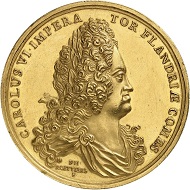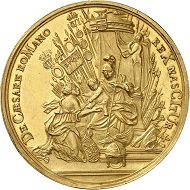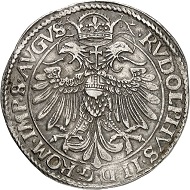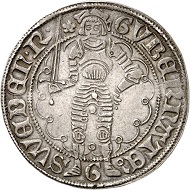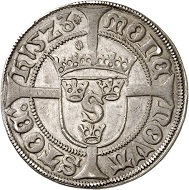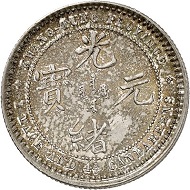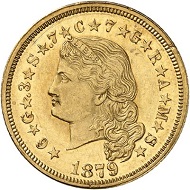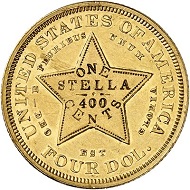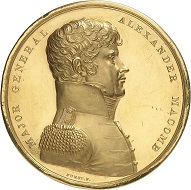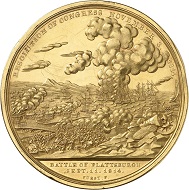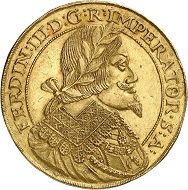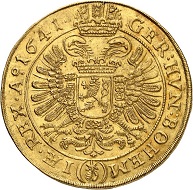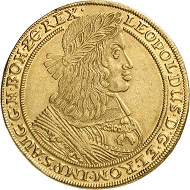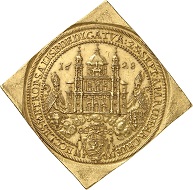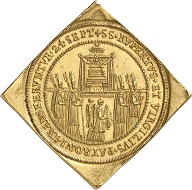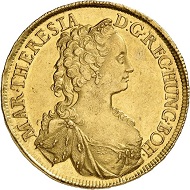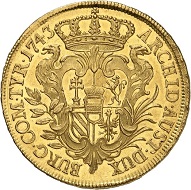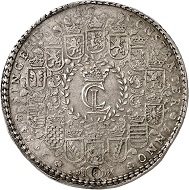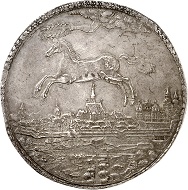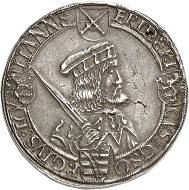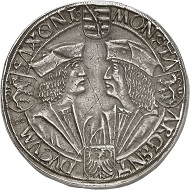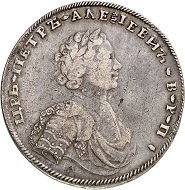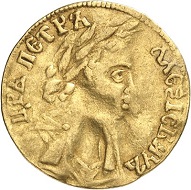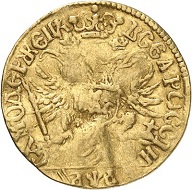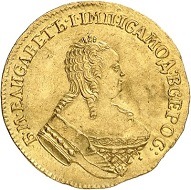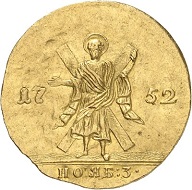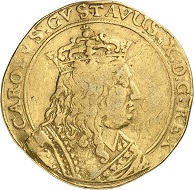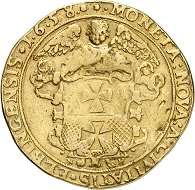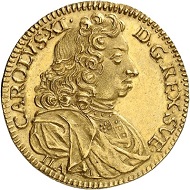01-02-2017 – 01-01-1970
Auctions 285-287
Künker’s Berlin Auction: 8.8 million euros hammer price on a single day
On February 2, 2017 collectors and dealers flocked to Berlin to attend the Künker Berlin Auction which kicked off the World Money Fair as usual. 713 world coins and medals in Catalog 285, and 250 coins from the Swedish possessions from the Ottar Ertzeid Collection were waiting for their new owners. In most cases, those had to pay considerably more than the pre-sale estimate. On an appraisal of 6 million euros, the result amounted to 8.8 million euros. This was due to the high prices for the gold coins from the Holy Roman Empire, the Russian coins and the early gold strikings from the United States of America.
Lot 3: Belgium. Flanders. Charles III (VI). Gold medal of 23 ducats 1716 by P. Roettiers on the birth of Archduke Leopold. Extremely rare. Extremely fine. Estimate: 15,000,- euros. Hammer price: 60,000,- euros.
Auction 285
Estimated at 15,000 euros, a gold medal of 23 ducats, featuring the portrait of Charles III as Count of Flanders on the birth of Archduke Leopold in 1716, finally brought 60,000 euros. This was only one of many impressive results. The extremely rare heavy variety of a pattern for the French 5 francs coin of 1853 rose from 2,500 euros to 16,000 euros.
Lot 83: Netherlands. Geldern. Reichstaler no date (1583). Extremely rare. Estimate: 5,000,- euros. Hammer price: 16,000,- euros.
The rare Dutch reichstalers brought similar prices: the 1603 specimen from Deventer realized 14,000 euros (estimate: 3,000 euros) and the one from Geldern no date (1583) even 16,000 euros (estimate: 5,000 euros).
Lot 115: Sweden. Gustav Vasa. 1/2 gyllen 1523, Stockholm. Unique. Extremely fine. Estimate: 30,000,- euros. Hammer price: 55,000,- euros.
Featuring King Gustav Vasa, standing in full armor on the obverse, a unique Swedish half gyllen from 1523 sold for 55,000 euros (estimate: 30,000 euros). An extremely rare heavy piece of 3 dalers from 1599 brought impressive 65,000 euros (estimate: 40,000 euros).
Lot 165: China. Kwangtung Province. 20 cents (4 mace) no date (1889). Very rare. Almost FDC. Estimate: 10,000,- euros. Hammer price: 22,000,- euros.
The excellent prices obtained by Chinese coins vouched for the fact that this area continues to be popular. To mention only two: a rare tael piece from the Hupeh Province from the year 30 (1904) changed hands for 17,000 euros (estimate: 3,000 euros), an almost FDC 20 cents piece from the Kwangtung Province no date (1889) for 22,000 euros (estimate: 10,000 euros).
Lot 189: USA. 5 dollars 1795, Philadelphia. “Capped Bust”. Very rare. Extremely fine. Estimate: 30,000,- euros. Hammer price: 48,000,- euros.
The early gold strikings from the United States of America obtained equally impressive hammer prices. On already substantial estimates, their prices increased markedly. The result for the Half Eagle “Capped Bust”, estimated at 30,000 euros, thus amounted to 48,000 euros.
Lot 191: USA. 4 dollars 1879, Philadelphia. “Stella flowing hair”. Very rare. Proof. Estimate: 40,000,- euros. Hammer price: 55,000,- euros.
On an appraisal of 40,000 euros, the extremely rare 4 dollars 1879 “Stella, flowing hair” realized nothing less than 55,000 euros. The punch reading “CAL” on a 2 1/2 dollars piece from Philadelphia from 1848 proved it to have been struck from the first gold coming from California. Having started at an estimated 17,500 euros, the hammer price was twice that sum, 32,000 euros.
Lot 214: USA. Congressional Gold Medal for Alexander Macomb (1782-1841). Unique, of outstanding historical importance. Extremely fine to FDC. Estimate: 150,000,- euros. Hammer price: 200,000,- euros.
The second most expensive lot of the whole Berlin auction was the Golden Congressional Gold Medal for Alexander Macomb, awarded by President James Madison himself to the Hero of Plattsburgh in 1814. The new owner had to finally bid 200,000 euros for it (estimate: 150,000 euros).
The Market for gold coins from the Holy Roman Empire is strong, how strong it is could be seen from the fact that four coins sold for six-digit prices and many more for five-figure results. Since it is impossible to mention all of them, we have to restrict ourselves to the top sellers and two surprises.
To start with the four top sellers:
Lot 238: Holy Roman Empire. Ferdinand III. 5 ducats 1641, Prague. Very rare. Extremely fine. Estimate: 20,000,- euros. Hammer price: 110,000,- euros.
- Ferdinand III, 5 ducats 1641, Prague (estimate: 20,000 euros / hammer price: 110,000 euros),
Lot 246: Holy Roman Empire. Leopold I. 10 ducats 1663, Breslau. Unedited, unique. Almost extremely fine. Estimate: 100,000,- euros. Hammer price: 140,000,- euros.
- Leopold I, 10 ducats 1663, Breslau (estimate: 100,000 euros / hammer price: 140,000 euros),
- Leopold I, 10 ducats 1696, Klausenburg (estimate: 40,000 euros / hammer price: 110,000 euros),
Lot 304: Salzburg. Paris von Lodron. Klippe of 30 ducats 1628 on the Cathedral’s consecration. Unedited, unique. Extremely fine. Estimate: 75,000,- euros. Hammer price: 160,000,- euros.
- Salzburg, Paris von Lodron, klippe of 30 ducats 1628 on the Cathedral’s consecration (estimate: 75,000 euros / hammer price: 160,000 euros).
Lot 277: Holy Roman Empire. Maria Theresia. 5 ducats 1743, Vienna. Very rare. Extremely fine. Estimate: 7,500,- euros. Hammer price: 80,000,- euros.
While it is not difficult to explain why those heavy gold multiples obtained such high prices, there were some surprises, too. An almost extremely fine 1680 ducat from Prague sold for nine times its estimate (estimate: 5,000 euros / hammer price: 44,000 euros). This was even surpassed by a 1743 5 ducats piece from Vienna with its beautiful juvenile portrait of Maria Theresia. On an estimate of 7,500 euros, the lot realized more than ten times when it went for 80,000 euros.
Lot 360: Brunswick-Lüneburg. Christian Ludwig, 1648-1665. Löser of 8 reichstalers 1654, Clausthal. Welter 1481. Probably unique. Very fine to extremely fine. Estimate: 100,000,- euros. Hammer price: 120,000 euros.
Compared against this, the prices for Germany seem rather modest, despite three results ranging in the 100,000-euros-region. A unique Braunschweig löser of 8 reichstalers depicting the Saxon Steed above the cityscape of Celle from 1654 was estimated at 100,000 euros, only to obtain a final hammer price of 120,000 euros.
Lot 455: Saxony. Friedrich III der Weise, Georg and Johann, 1500-1507. Thick triple guldengroschen no date (1500-1507), Annaberg. Extremely rare. Very fine to extremely fine. Estimate: 75,000,- euros. Hammer price: 100,000,- euros.
The triple guldengroschen of the Saxon Electors, minted under Friedrich III der Weise and his brothers between 1500 and 1507, sold for 100,000 euros (estimate: 75,000 euros). 95,000 euros was the hammer price of a 5 ducats piece of Johann Georg I von Sachsen, minted in Dresden in 1614 (estimate: 50,000 euros).
Lot 603: Russia. Peter I. Roubel 1707, Moscow, Kadashevsky Mint. Ex Hutten-Czapski Coll. (with collector’s punch). Very rare. Good very fine. Estimate: 250,000,- euros. Hammer price: 290,000,- euros.
The market for Russian coins is healthy, as long as the coins offered are rare and / or of an exceptionally good grade. And the coins of the Künker Berlin auction were meeting these criteria. A very rare roubel of Peter the Great from the Moscow Kadashevsky Mint from 1707 was estimated at impressive 250,000 euros. That estimate was even exceeded. To the applause of the entire auction room, the hammer went down at 290,000 euros. And there were more high results to come.
Lot 599: Russia. Peter I. Ducat 1701, Moscow, Kadashevsky Mint. Very rare. Almost very fine. Estimate: 25,000,- euros. Hammer price: 70,000,- euros.
A 1701 ducat struck at the same Mint, slightly bent and graded only almost very fine but of utmost rarity, sprang a surprise with many attendees when, on an estimate of 25,000 euros, it finally brought 70,000 euros. Probably of equal rarity and produced by the same Mint, a good very fine 1702 poltina of Peter realized 130,000 euros, its clearly visible adjustment marks notwithstanding (estimate: 40,000 euros).
Lot 642: Russia. Elizabeth, 1741-1761. Ducat 1752, Moscow, Red Mint. Very rare. Only 9,398 specimens struck. Extremely fine. Estimate: 50,000,- euros. Hammer price: 85,000,- euros.
Skipping further remarkable results, we conclude this section with a ducat of Tsarina Elizabeth from 1752, minted by the Moscow Red Mint. Featuring Saint Andrew on its reverse, it went for 85,000 euros (estimate: 50,000 euros).
Auction 286: The Ottar Ertzeid Collection: Coins from the Swedish Possessions
There is good news for all of us: You don’t have to be a millionaire to collect interesting coins – even though that is exactly what a not that experienced observer of Auction 285 could have thought. Thrilling coins can also be found in the three- and four-digit region. And when a collection as the one assembled by Ottar Ertzeid enters the market, there is something for every budget. That is why Künker makes a point offering lots with low estimates to the collector as well, through the platform of the eLive Premium Auction. This gives everybody the chance to participate in the auction and to acquire his favorite numismatic item.
Lot 1034: Ottar Ertzeid Coll. Swedish possessions. Elbing. Charles X. 10 ducats 1658. 4th known specimen. Almost very fine. Estimate: 25,000,- euros. Hammer price: 48,000,- euros.
This preview can of course single out only the highest results. Top seller was a heavy gold coin, a 10 ducat piece from 1658, struck in Elbing under Charles X Gustav (estimate: 25,000 euros / hammer price: 48,000 euros). With 44,000 euros almost as high was the price of a 4 ducat piece from 1634, whose dies had been cut in Wolgast, on the death of Gustavus II Adolphus (estimate: 20,000 euros).
Lot 1080: Ottar Ertzeid Coll. Swedish possessions. Pomerania. Charles XI. Ducat 1690, Stettin. 2nd specimen in private possession. Extremely fine. Estimate: 8,000,- euros. Hammer price: 28,000,- euros.
A 1690 ducat from Stettin, on the other hand, turned out to be a surprise. Struck under Charles XI and graded extremely fine, the specimen was of the utmost rarity and therefore sold for 28,000 euros (estimate: 28,000 euros).
All results can be viewed on the company’s website. The next auction will take place on March 13-17, 2017 in Osnabrück. The catalogs can be ordered at Künker, Nobbenburgerstr. 4a, 49 076 Osnabrück; phone: 0541 / 96 20 20; fax: 0541 / 96 20 222; or by email.





